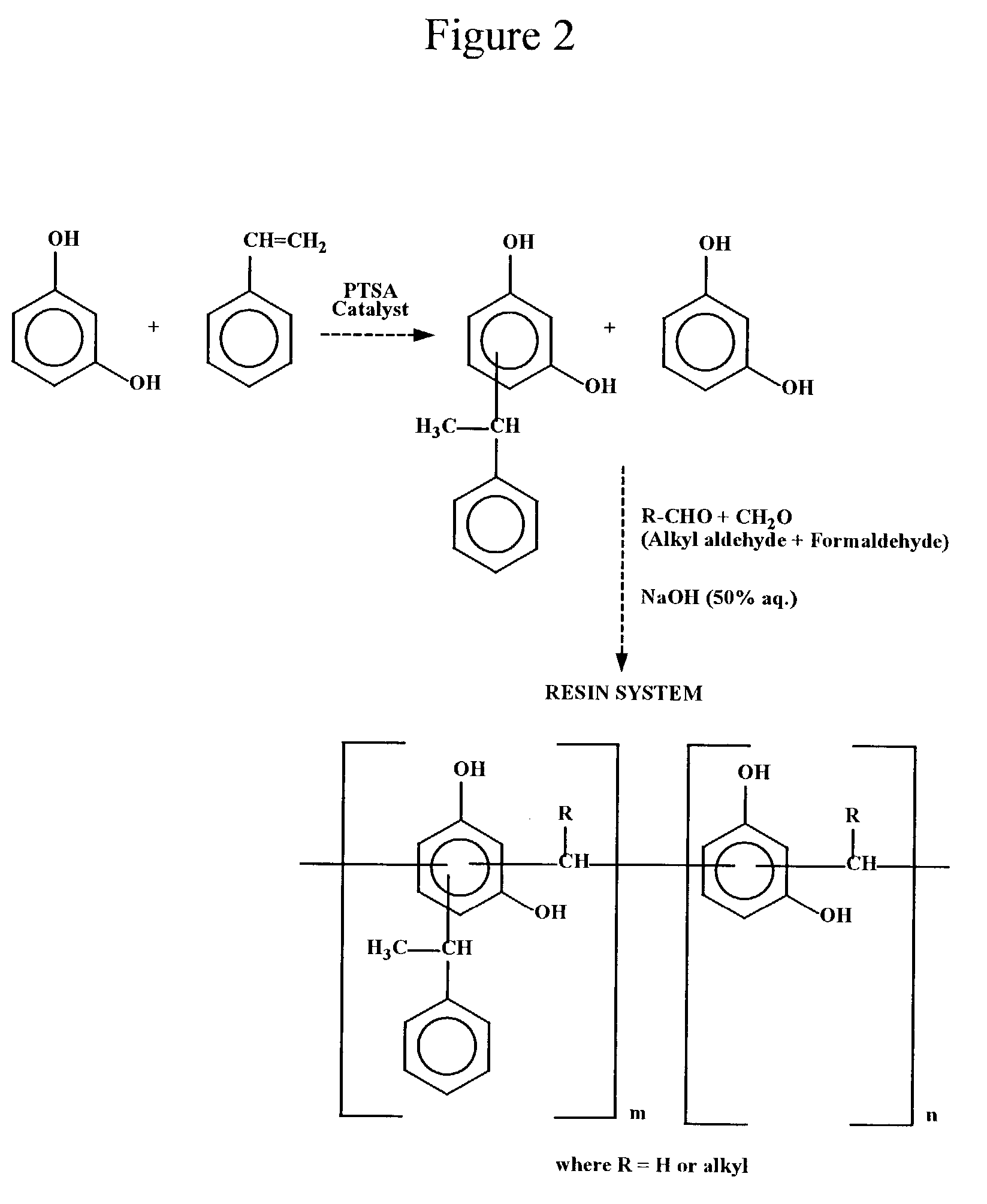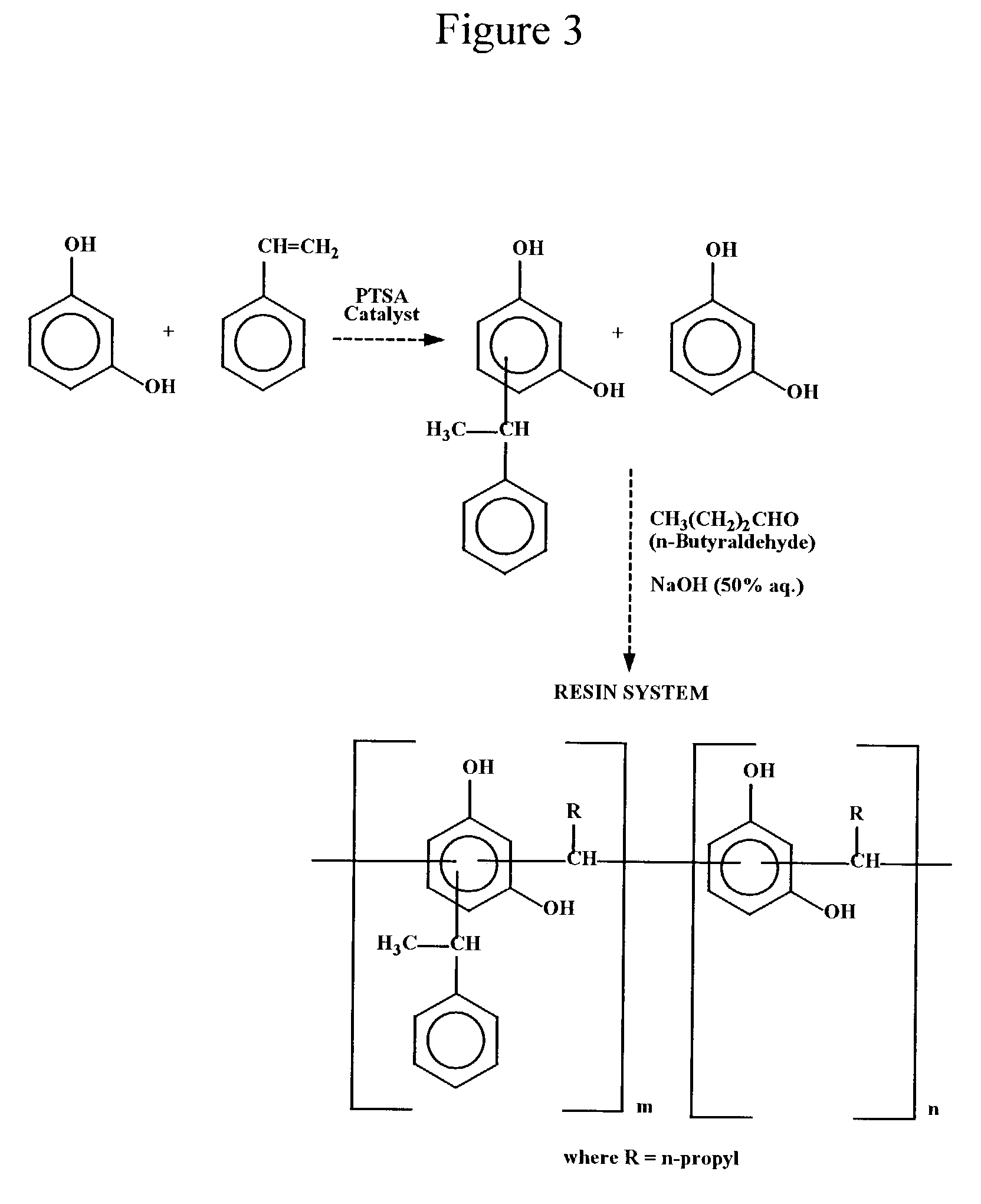Modified resorcinol resins and applications thereof
a technology of resorcinol and novolak, which is applied in the field of resorcinol novolak resins, can solve the problems of unsatisfactory results, health and environmental protection problems, and less effective adhesion than free resorcinol
- Summary
- Abstract
- Description
- Claims
- Application Information
AI Technical Summary
Problems solved by technology
Method used
Image
Examples
example 3
Synthesis of Styrene Modified Resorcinol-Butyraldehyde Resin
[0062]Into a 500 mL reaction kettle equipped with a stirrer, thermometer, reflux condenser and an addition funnel, 110.1 grams (1.0 mole) of resorcinol were charged and heated to 120–130° C. p-Toluene sulfonic acid (1.0 gram) was then added at 120° C. and mixed for 5 minutes. Then 62.4 grams (0.6 mole) of styrene were added dropwise over a period of 60–120 minutes at 120–135° C. After all the styrene had been added, the reaction mixture was maintained at that temperature for an additional 30–60 minutes. After this, the temperature was raised to 150–155° C. and the contents were stirred for an additional 30 minutes to complete the resorcinol-styrene reaction. Then 46.8 grams (0.65 mole) of butyraldehyde were added slowly into the kettle for a period of 45–60 minutes at 90–120° C. The reaction mixture was held at reflux for 30–60 minutes more. After the reflux, 0.5 gram of 50% sodium hydroxide solution was added to neutralize...
example 4
Synthesis of Styrene Modified Resorcinol-Iso-Butyraldehyde Resin
[0066]Into a 500 mL reaction kettle equipped with a stirrer, thermometer, reflux condenser and an addition funnel, 110.1 grams (1.0 mole) of resorcinol were charged and heated to 120–130 ° C. p-Toluene sulfonic acid (1.0 gram) was then added at 120° C. and mixed for 5 minutes. Then 72.8 grams (0.7 mole) of styrene were added dropwise over a period of 60–120 minutes at 120–135 ° C. After all the styrene had been added, the reaction mixture was maintained at that temperature for an additional 30–60 minutes. After this, the temperature was raised to 150–155° C. and the contents were stirred for an additional 30 minutes to complete the resorcinol-styrene reaction. Then 43.2 grams (0.6 mole) of isobutyraldehyde were added slowly into the kettle for a period of 45–60 minutes at 90–120° C. The reaction mixture was held at reflux for 30–60 minutes more. After the reflux, 0.5 gram of 50% sodium hydroxide solution was added to ne...
example 5
Synthesis of Styrene Modified Resorcinol-Butyraldehyde-Formaldehyde Resin
[0070]Into a 500 mL reaction kettle equipped with a stirrer, thermometer, reflux condenser and an addition funnel, 110.1 grams (1.0 mole) of resorcinol were charged and heated to 120–130° C. p-Toluene sulfonic acid (1.0 gram) was then added at 120° C. and mixed for 5 minutes. Then 72.8 grams (0.7 mole) of styrene were added dropwise over a period of 60–120 minutes at 120–135° C. After all the styrene had been added, the reaction mixture was maintained at that temperature for an additional 30–60 minutes. After this, the temperature was raised to 150–155° C. and the contents were stirred for an additional 30 minutes to complete the resorcinol-styrene reaction. Then 14.4 grams (0.20 mole) of butyraldehyde were added slowly into the kettle for a period of 45–60 minutes at 90–120° C. The reaction mixture was held at reflux for 30–60 minutes more after the butyraldehyde addition. Then 37.0 grams (0.45 mole) of formal...
PUM
 Login to view more
Login to view more Abstract
Description
Claims
Application Information
 Login to view more
Login to view more - R&D Engineer
- R&D Manager
- IP Professional
- Industry Leading Data Capabilities
- Powerful AI technology
- Patent DNA Extraction
Browse by: Latest US Patents, China's latest patents, Technical Efficacy Thesaurus, Application Domain, Technology Topic.
© 2024 PatSnap. All rights reserved.Legal|Privacy policy|Modern Slavery Act Transparency Statement|Sitemap



